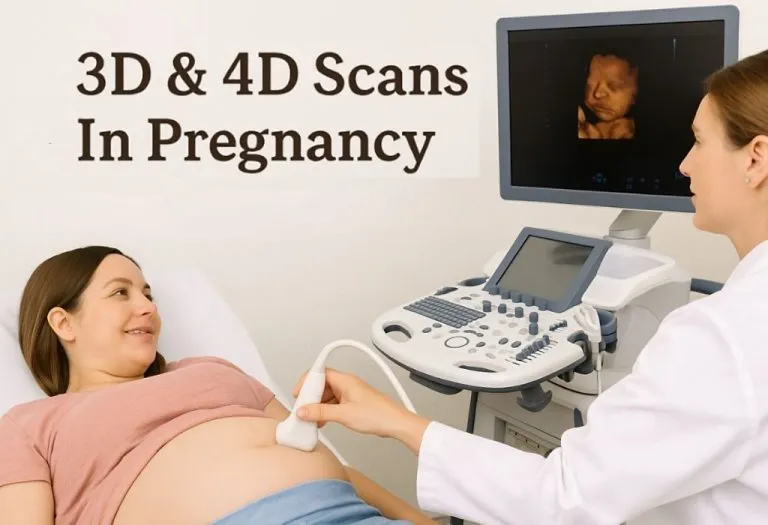3D & 4D Scans In Pregnancy

It is always magical to see your unborn baby in its almost actual form. Seeing this creates a certain connection with the parents, who are eagerly waiting to get a glimpse of their baby. 3D and 4D scans have made this possible in a very realistic way. 3D and 4D ultrasound examinations provide a more detailed view of your unborn child compared to a traditional 2D ultrasound. With a 3D & 4D scan in pregnancy, you can observe a true representation of the baby, showcasing features like the skin, nose, and tongue rather than just internal organs. You will be able to witness your baby’s activities in the womb, such as kicking or yawning. Here is everything you should know about 3D or 4D imaging.
What Are 3D & 4D Scans in Pregnancy?
Ultrasound scans, such as 3D and 4D, are like real-time photos of your baby. In a 3D scan, multiple 2D images of the baby are taken and then combined to create a 3D image effect. In a 4D scan, pictures are taken in real-time, allowing you to see what your baby is doing inside you at that moment, such as moving its legs and arms or even opening and closing its eyes. This is more like live streaming or a video. The time component is the fourth dimension added to the 3D scan, and hence, it is referred to as a 4D scan.
Is 3D & 4D Scan Safe During Pregnancy?
Currently, there is no evidence to suggest that ultrasound has any harmful effects on the unborn baby. As recommended by the American College of Obstetricians and Gynecologists (ACOG), ultrasounds are generally safe and should be performed for medical purposes by a qualified medical practitioner only (1).
When an ultrasound is performed, it transmits heat in the tissue, creating gas bubbles in the tissue along with body fluids. Continuous exposure to ultrasound may harm the body in the long run; therefore, it should only be performed for medical reasons. The ACOG recommends that pregnant women undergo a 2D ultrasound test between 18 and 22 weeks of pregnancy.
Difference Between 2D, 3D, and 4D Scans
A decade ago, pregnant moms could see their babies before they were born with the help of 2D scans. However, 2D scans had some limitations. One could see only grey and hazy images of the baby. Such scans were useful only to see the internal organs, as the ultrasound waves used to create pictures of the baby’s organs and not their complete form.
These days, mothers-to-be are far luckier and can see what their little one actually looks like before birth. 3D scans are far superior to 2D ones, as they take images from various angles that help see baby’s face or organs in greater detail (2). The pieces of the scanned photos are assembled to create a more realistic-looking baby’s form. You can see your baby’s face, legs and arms (3).
4D scans have further improved technology and software, and help you see the baby in real-time (live) (4). Now, the parents-to-be can see their cutie-pie moving, yawning, kicking, blinking its eyes, and sucking. It is a delight to see what technology has to offer in terms of baby scans. Though all these scans are done for medical reasons, they help create a bond between the parents and the baby, and nothing can match the joy it gives to the parents.
Why You Need a 3D and 4D Pregnancy Scan?
Ultrasound scans are an important tool to check the internal organs and health of a growing foetus. They help the gynaecologist identify whether the baby has any complications or not. This identification helps them treat the baby at the earliest. These scans help the doctor monitor the baby for any anomalies such as cleft lip, spinal cord problems and other birth defects. They also help the doctor monitor amniotic fluid levels.
When Do You Need a 3D & 4D Scan in Pregnancy?
These ultrasound scans are optional. They are not a part of the prenatal tests. If you do not want to undergo any of these scans, it is perfectly fine, and you can keep your doctor informed accordingly. The doctor will advise you if she sees a medically relevant need or some probable complication. If you decide to have a scan, it is usually done between 26 and 30 weeks. It is best not to take it earlier because the baby would not have fat under their skin. So, it is possible that you might not get clear images of your baby.
How Does a 3D and 4D Scan Work?
An ultrasound scan is also known as sonography, as it uses high-frequency sound waves to get image slices of the baby. This is how such scans work:
- A transducer or a probe is a device used to send ultrasound signals inside the womb. The transducer is first coated with a conductive gel that helps the waves penetrate smoothly.
- The ultrasound signals, upon encountering an obstacle or structure, are reflected back, and the software captures them as images on the computer screen.
- The strength and time of the reflecting waves create images, and this information is captured as pictures or videos.
- These slices are then assembled to get a photograph of the baby.
3D and 4D Scan Results
These scans are not standard diagnostic procedures in prenatal tests. They are merely indicative of possible complications or any birth defects. Therefore, it is up to the doctor to interpret the results. If she notices any possible complications, further investigative tests will be advised.
How Often the Scan is Done?
It is quite common for doctors to do a 2D scan on a regular basis to keep track of the baby’s progress. It is generally a good test to know the baby’s vitals, amniotic fluid levels, and the baby’s growth. The 3D and 4D scans are not recommended as much as the 2D scans. They are only done to study the foetus closely and look for any birth defects. While there is no reliable evidence to suggest that 3D and 4D scans could be harmful to the baby or the mother in any way, it is recommended to limit them and consult your doctor before opting for them privately.
Advantages of 3D & 4D Scan During Pregnancy
3D Scan
- It has better visualisation of foetal heart structures because it projects views that are not attainable by 2D imaging.
- It helps diagnose foetal face defects like a cleft lip (5).
- It helps diagnose foetal musculoskeletal or neural defects.
- It takes less time to obtain standard plane visualisation.
- It is easy to study and does not require a very skilled or experienced person for a diagnosis of common foetal anomalies.
- The recorded volume data can be made available virtually for expert opinion and better diagnosis.
4D Scan
- Shorter time for foetal heart screening and diagnosis.
- Data obtained during the scan can be sent for expert review even to doctors residing in remote areas. It can also be used for training purposes.
- Enhanced parental bonding with the baby.
- Positive bonding with the baby during pregnancy as a result of seeing the baby in real-time.
- Families and fathers are more supportive after seeing the baby’s form and movement.
- The probability of obtaining a more accurate identification of foetal anomalies is higher in 4D scans.
- Additionally, it shares the benefits of 3D ultrasound, such as:
- Assessment of foetal growth and well-being, including fetal face, breathing movements, grimacing, swallowing, isolated eye-blinking, mouthing and reveals the direction of the limbs (6)
- Placental localisation and assessment
- Examining the foetal heartbeat
Disadvantages of 3D & 4D Scan in Pregnancy
3D Scan
- The only setback in 3D sonography in pregnancy is that it does not give us a real-time or live streaming of the baby’s movements.
- A 3D baby scan requires high-speed computing software.
4D Scan
- Expensive machinery.
- Intensive training is required to operate the machinery.
What Is Pregnancy 3D & 4D Scan Cost?
3D & 4D scan pregnancy prices are relatively cost-friendly, ranging from Rs 750 to Rs 3000.
FAQs
1. Who gets the ultrasound tests during pregnancy?
Women at low risk for complications typically undergo the ultrasound process only once. In contrast, those with a higher risk of encountering issues or the possibility of multiple births often require additional testing. The reasons for undergoing the test can vary depending on the trimester. However, 3D and 4D ultrasounds are considered optional.
2. What are the side effects of 3D and 4D scans?
While there are no known side effects of the diagnostic ultrasounds, they may occasionally cause a slight increase in tissue temperature. This increase in tissue temperature can lead to the formation of gas pockets within the tissue. Therefore, it is recommended to undergo ultrasound procedures only when advised by a healthcare professional. Over the past two decades, no studies have indicated that it causes harm to either the mother or the baby, but it is best to steer clear of it whenever possible.
Although these scans are not a part of the standard medical procedure, it is always a pleasure to see your baby moving inside you. 3D and 4D scans are among the most sought-after scans requested by parents. It is magical to see your growing baby. If you want to undertake these scans during your pregnancy, consult your doctor and follow his advice.
Also Read:
NT Scan in Pregnancy
First Trimester Scans in Pregnancy
Anomaly Scan during Pregnancy
Was This Article Helpful?
Parenting is a huge responsibility, for you as a caregiver, but also for us as a parenting content platform. We understand that and take our responsibility of creating credible content seriously. FirstCry Parenting articles are written and published only after extensive research using factually sound references to deliver quality content that is accurate, validated by experts, and completely reliable. To understand how we go about creating content that is credible, read our editorial policy here.
2. Cleveland Clinic – Ultrasound in Pregnancy
3. UT Southwestern Medical Center – Why to avoid ‘keepsake’ 3-D and 4-D ultrasounds
5. PubMed Central – Three- and Four-Dimensional Ultrasound in Obstetric Practice: Does it Help?
6. PubMed Central – The Role of 4D Ultrasound in the Assessment of Fetal Behaviour
























